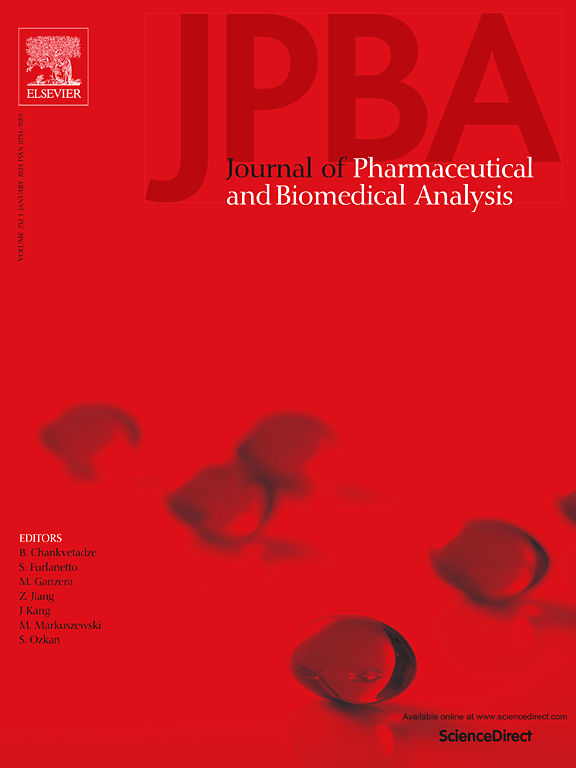LC-HRMS-based global metabolomics profiling unravels the distinct metabolic signature of lapatinib-resistant and trastuzumab-resistant HER2+ breast cancer cells
IF 3.1
3区 医学
Q2 CHEMISTRY, ANALYTICAL
Journal of pharmaceutical and biomedical analysis
Pub Date : 2024-10-16
DOI:10.1016/j.jpba.2024.116528
引用次数: 0
Abstract
The effectiveness of lapatinib (LAP) and trastuzumab (TRZ), the first-line therapies for HER2+ breast cancer, has been limited owing to the development of acquired resistance in patients with HER2+. This study aimed to investigate the alterations in metabolic signatures in LAP-resistant HCC1954 and TRZ-resistant HCC1954 and pathways in human HER2+ breast cancer cells using liquid chromatography–high-resolution mass spectrometry (LC-HRMS) and enrichment analysis. The HCC1954 parental cells were sequentially treated 13 rounds with LAP or TRZ to develop resistant cells and then tested for their cytotoxicity using the MTT assay. Metabolites were prepared from HCC1954 parental (MBXWT), HCC1954-LAP (MBXLAP), and HCC1954-TRZ (MBXTRZ) cells prior to LC-HRMS, chemometric, enrichment, and joint pathway analyses. LAP- and TRZ-resistant cells were successfully developed from HCC1954, and 29 and 17 differentially expressed metabolites (DEMs) were identified between MBXWT-MBXLAP and MBXWT-MBXTRZ, respectively. The analysis of DEMs between MBXWT and MBXLAP revealed significant enrichment in D-amino acid metabolism, while MBXWT and MBXTRZ identified valine, leucine, isoleucine biosynthesis, ascorbate, and aldarate metabolism. Joint pathway enrichment analysis of LAP-resistant DEMs and differentially expressed genes (DEGs) showed enrichment in glutathione metabolism, while that of TRZ-resistance and DEGs showed enrichment in carbohydrate metabolism, namely pentose and glucuronate interconversions, starch and sucrose metabolism, and galactose metabolism. The findings from this study indicate considerable metabolic changes in LAP- and TRZ-resistant HCC1954 cells, which are crucial for understanding the resistance mechanisms and developing strategies to overcome these problems.
基于 LC-HRMS 的全局代谢组学分析揭示了拉帕替尼耐药和曲妥珠单抗耐药 HER2+ 乳腺癌细胞的独特代谢特征。
拉帕替尼(LAP)和曲妥珠单抗(TRZ)是治疗HER2+乳腺癌的一线疗法,但由于HER2+患者出现获得性耐药,其疗效受到限制。本研究旨在利用液相色谱-高分辨质谱法(LC-HRMS)和富集分析法研究对LAP耐药的HCC1954和对TRZ耐药的HCC1954中代谢特征的改变,以及人类HER2+乳腺癌细胞中的代谢途径。用 LAP 或 TRZ 对 HCC1954 亲本细胞进行 13 轮连续处理,培养出耐药细胞,然后用 MTT 试验检测其细胞毒性。在进行 LC-HRMS、化学计量学、富集和联合途径分析之前,从 HCC1954 亲本细胞(MBXWT)、HCC1954-LAP(MBXLAP)和 HCC1954-TRZ (MBXTRZ)细胞中制备代谢物。成功地从 HCC1954 培育出了 LAP 和 TRZ 抗性细胞,并在 MBXWT-MBXLAP 和 MBXWT-MBXTRZ 之间分别鉴定出 29 和 17 个差异表达代谢物(DEMs)。MBXWT 和 MBXLAP 之间的 DEMs 分析表明,D-氨基酸代谢显著富集,而 MBXWT 和 MBXTRZ 则发现了缬氨酸、亮氨酸、异亮氨酸生物合成、抗坏血酸和醛酸代谢。对 LAP 抗性 DEMs 和差异表达基因(DEGs)的联合通路富集分析表明,谷胱甘肽代谢富集,而对 TRZ 抗性和差异表达基因的联合通路富集分析表明,碳水化合物代谢富集,即戊糖和葡萄糖醛酸的相互转化、淀粉和蔗糖代谢以及半乳糖代谢。本研究的结果表明,LAP和TRZ耐药的HCC1954细胞的代谢发生了很大变化,这对于了解耐药机制和制定克服这些问题的策略至关重要。
本文章由计算机程序翻译,如有差异,请以英文原文为准。
求助全文
约1分钟内获得全文
求助全文
来源期刊
CiteScore
6.70
自引率
5.90%
发文量
588
审稿时长
37 days
期刊介绍:
This journal is an international medium directed towards the needs of academic, clinical, government and industrial analysis by publishing original research reports and critical reviews on pharmaceutical and biomedical analysis. It covers the interdisciplinary aspects of analysis in the pharmaceutical, biomedical and clinical sciences, including developments in analytical methodology, instrumentation, computation and interpretation. Submissions on novel applications focusing on drug purity and stability studies, pharmacokinetics, therapeutic monitoring, metabolic profiling; drug-related aspects of analytical biochemistry and forensic toxicology; quality assurance in the pharmaceutical industry are also welcome.
Studies from areas of well established and poorly selective methods, such as UV-VIS spectrophotometry (including derivative and multi-wavelength measurements), basic electroanalytical (potentiometric, polarographic and voltammetric) methods, fluorimetry, flow-injection analysis, etc. are accepted for publication in exceptional cases only, if a unique and substantial advantage over presently known systems is demonstrated. The same applies to the assay of simple drug formulations by any kind of methods and the determination of drugs in biological samples based merely on spiked samples. Drug purity/stability studies should contain information on the structure elucidation of the impurities/degradants.

 求助内容:
求助内容: 应助结果提醒方式:
应助结果提醒方式:


